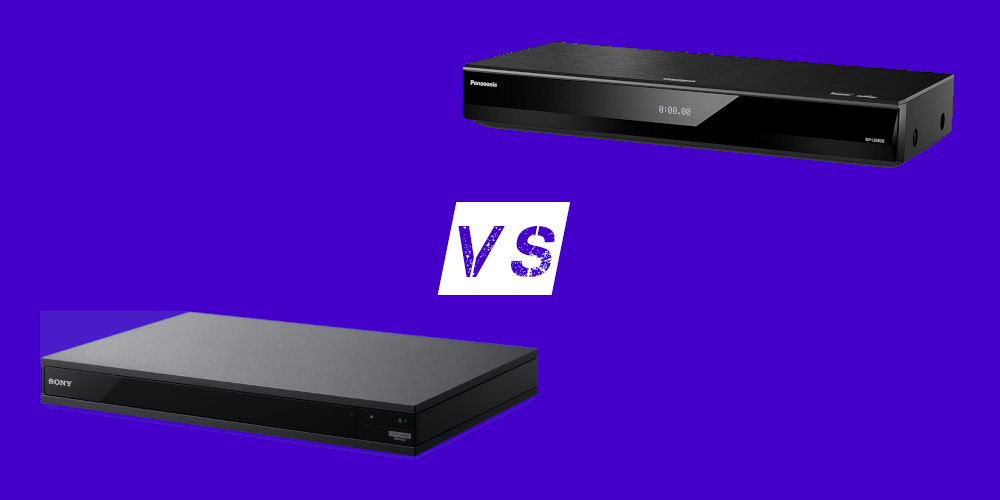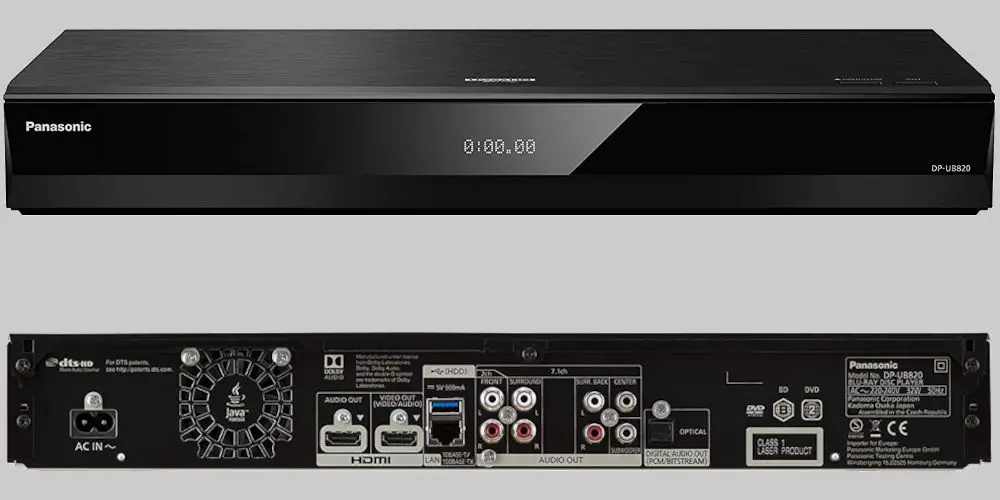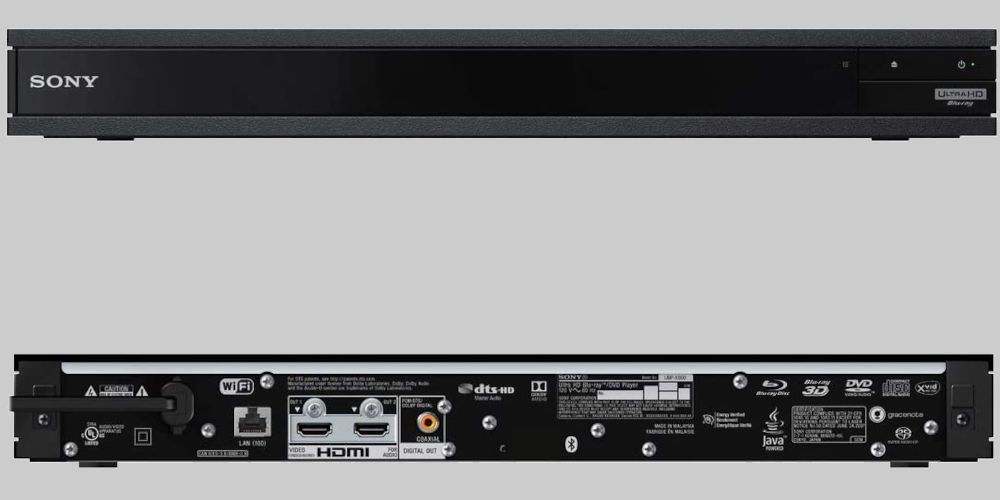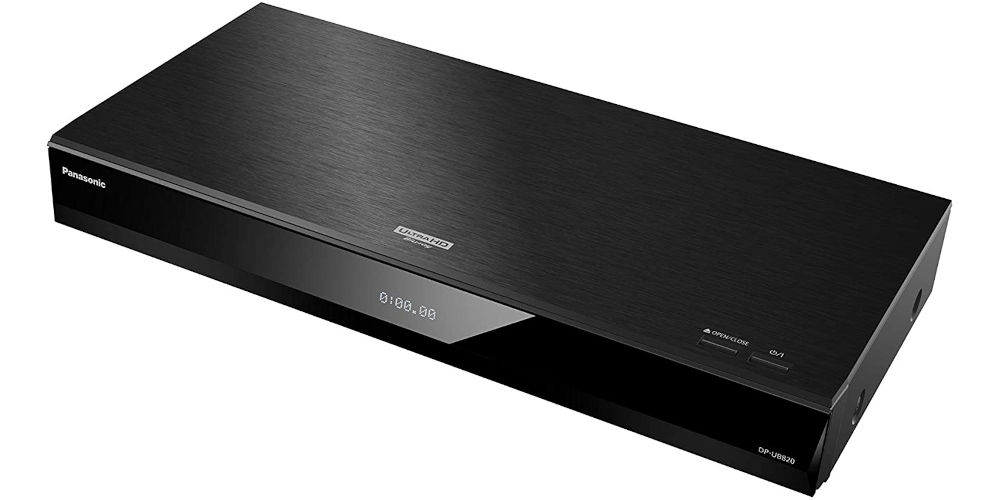Panasonic DP-UB820 vs Sony UBP-X800M2 comparison

Comparing premier Blu-ray players from two of the world’s best-known brands is a tall order. Yet when looking at Panasonic DP-UB820 vs Sony UBP-X800M2, you might opt for the slightly cheaper option, the Sony.
However, if your only criteria is price, you might miss out on features that you actually require to make movie watching more enjoyable.
At first glance, they appear similar. Both have a generic black boxy design, play a range of file formats, and are feature-packed, Not to mention, both are relatively affordable. Yet, on closer inspection, many differences start to reveal themselves.
The Panasonic DP-UB820 offers control using Google Assistant or Amazon Alexa. On the rear, you’ll spot it offers a range of outputs, including phonos 7.1 surround sound. So, you don’t an AV receiver, just powered speakers.
While the Sony UBP-X800M2 doesn’t offer as many audio outputs. It is more technologically advanced, with an inbuilt HDR to SDR converter, several HDR options, and support for Dolby Atmos and DTS: X.
As you shouldn’t struggle when deciding between the Panasonic DP-UB820 vs Sony UBP-X800M2 Blu-ray players, we’ve done the hard work for you! Here’s an honest, direct comparison of these two excellent 4K Blu-ray players.
Panasonic DP-UB820 Blu-ray player overview

photo by Panasonic
Under the sleek design, the Panasonic DP-UB820 Blu-ray Player offers true to life colours and texture, onboard 4K upscaling, and access to your favourite streaming services. It’s even voice control ready!
Built around Panasonic’s unique HCX (Hollywood Cinema Experience) processor, the result is excellent picture quality. Each frame displays stunning depth and texture with true to life colour.
As a 4K Blu-ray player, you can play CDs, DVDs, 3D Blu-rays, 4k Blu-rays, and more. The unit also supports High Dynamic Range pictures (HDR10, HDR10+, and Dolby Vision) and HLG (Hybrid Log-Gamma HDR) formats.
The Panasonic DP-UB820 also produces fantastic audio. Enjoy Hi-Res music via streaming or using the USB port and discover hidden depths in your favourite tracks. Plus, with 7.1 phono outputs, you can run a powered surround sound system.
As more than a Blu-ray player, connect the DP-UB820 to Wi-Fi and access your favourite streaming services, a multitude of apps, and a web browser. Also, when connected to Wi-Fi, you to control the unit using Google Assistant or Amazon Alexa.
Sony UBP-X800M2 Blu-ray player overview

photo by Sony
The Sony UBP-X800M2 Ultra HD 4K Blu-ray Player offers exceptional picture quality, support for Dolby Vision, HDR10 and HLG, and many other superb features. Built to an exceptional standard to ensure noise-less operation and longevity, you’ll enjoy the unit for many years to come.
Regardless if you’re playing the latest releases in 4K or an old format, the UBP-X800M2 displays each frame with a higher level of detail than before. Offering High Dynamic Range (HDR), each picture comes alive with new brightness, shades and colours.
The onboard audio is equally impressive as it supports Dolby Atmos and DTS:X decoders and High-Resolution Audio. Listen as lightning cracks, sirens wail, and car horns blare all around you in startling clarity.
Beyond playing a range of disc formats, you can use the Sony UBP-X800M2 to watch, listen, and stream content, thanks to its built-in Wi-Fi! There’s also a USB port enabling you to enjoy even more formats!
Offering several outputs, The UBP-X800M2 also supports Bluetooth audio transmission. Simply pair your favourite Bluetooth headphones with the unit and enjoy a private viewing, without wires. The remote even has a Netflix button, allowing for easy access.
Design
Putting the uninspiring designs to one side, the Sony UBP-X800M2 build quality is far superior to the Panasonic DP-UB820. The casing uses Sony’s unique Frame and Beam chassis for excellent vibration resistance. These construction techniques are usually reserved for high-end Hi-Fi systems.
Both units hide their USB port and disc tray behind a folding panel. Thanks to their sleek looks, it’s easy to imagine either unit slotting into an existing lounge or home cinema room. That said, neither has any control buttons on the unit other than a power on/off button and disc tray open/close.
The rear is where the Panasonic pushes ahead as it offers far more options than the Sony. While this shouldn’t be the basis for your choice, it’s worth bearing in mind what connectivity a unit offers and your requirements.
The unimaginative design continues to the remotes. Both look fairly similar with an array of basic controls. The Sony also has buttons for Netflix, Bluetooth function, favourites and TV controls. While the Panasonic has buttons for Netflix, internet, HDR setting, and controlling a TV.
Winner: tie
Features
The Sony UBP-X800M2 offers support for Dolby Vision, HDR10+ and HLG formats. Plus, it has an inbuilt HDR to SDR converter ensuring you always watching the best picture quality possible. With audio, there is support for Dolby Atmos and DTS: X.
A Bluetooth output allows for seamless connection with Bluetooth headphones or speakers. But that’s not all, the Sony UBP-X800M2 uses LDAC for improved Bluetooth sound transferring around 3x the data.
What makes the Panasonic DP-UB820 impressive is the extensive list of extras. One point of difference is it supports 3D movies. And as with the Sony, the Panasonic supports Dolby Vision, HDR10+ and HLG formats.
A feature unique to the DP-UB820 is the 7.1 surround sound outputs. While not powered, they remove the need for an AV receiver. Another feature that pushes it above the Sony is you can use Amazon Alexa or Google Assistant to control the Panasonic DP-UB820 using your voice.
Winner: Panasonic
Connectivity
Despite the similarities of the front panels, the Panasonic offers plenty of additional features on the rear. The Sony unit still offers a good range of connectivity options. However, it has a fitted power cable, which we’re not massive fans of as it removes some of the flexibility.
Both units have the same basic connections of 2 HDMI ports (1 x video and audio, 1 x audio only), optical audio output, Ethernet port and power socket/cable. They also both have built-in Wi-Fi, giving you options.
The major difference is the Panasonic also offers a second USB port and 7.1 surround sound via passive phono outputs. These are ideal if you already have powered speakers and want to bypass needing an AV receiver.
As both offer the same basic connectivity options, they are highly flexible. That said the Panasonic has the edge.
Winner: Panasonic
Set-up
With fewer options, the Sony UBP-X800M2 is slightly easier to set up. While this shouldn’t surprise you, it still offers a good amount of flexibility. Of course, if you’re after flexibility, the Panasonic is a better option.
The simplest set up with both units is to connect an HDMI cable from your TV to the Blu-ray player. You’ll be up and running in minutes. If you want to get a little more complicated, you could add a soundbar or external speaker using the optical audio output.
As you can connect a surround sound speaker set up to the Panasonic DP-UB820, the set up process can be trickier.
If you’re a big fan of streaming, you might decide to use a hard-wired internet connection over the built-in Wi-Fi. That said, both units have excellent Wi-Fi capabilities.
Both have dual HDMI ports. So, you could connect the first HDMI port to supply video to a TV or projector and the second HDMI port to feed audio to an AV receiver, which powers a surround speaker system.
Winner: Sony
Performance
The Panasonic has a more developed user interface, compared to the basic Java-based OS of the Sony unit. And so feels more modern and inviting. That said, as you can control the Panasonic DP-UB820 using your voice, it’s superior to the Sony UBP-X800M2.
Noise can easily ruin your experience. Quite often, the reason for unwanted noise is bad design. The Sony unit is over-engineered, meaning it’s dead quiet. Compared the Panasonic, if you care about build quality, you’ll want to buy the Sony UBP-X800M2.
Both units do a great job of handling multiple formats and resolutions. To the untrained eye, the difference between them is hard to spot, especially as both upscale content to near 4K picture quality.
The Sony, however, does offer more extras, including support for Dolby Atmos and DTS: X. So, if you care about enjoying the latest surround sound experience, consider buying the Sony.
While both units have USB ports, extending the number of formats you can enjoy. The Sony unit has an issue. You can’t select a specific timestamp. So, you’ll need to manually fast forward/rewind using the remote. In this regard, the Panasonic is more flexible and user-friendly.
Neither does well on a range of available apps. Both lack the option of using an app store to download a wider range. And so, you’re stuck to the pre-installed ones. That said, if you want access to more apps, a streaming stick is one solution.
Winner: Panasonic
Panasonic DP-UB820 vs Sony UBP-X800M2 Blu-ray player: Which is better?

photo by Panasonic
While the Sony UBP-X800M2 is better built and technologically superior, we’ve chosen the Panasonic DP-UB820 as the winner of our Panasonic DP-UB820 vs Sony UBP-X800M2 comparison.
The Panasonic DP-UB820 offers more connectivity flexibility, plays a wider range of formats, and allows for voice control. Plus, some users have noticed with the Sony UBP-X800M2 that it’s difficult to use the USB function. Sony is yet to release a firmware update to correct this issue.
Granted, for some users, the Sony UBP-X800M2 will be superior in every way, despite the native 7.1 surround sound outputs or voice control provided by the Panasonic. But, we urge you to seriously consider the Panasonic and spend the extra cash.




